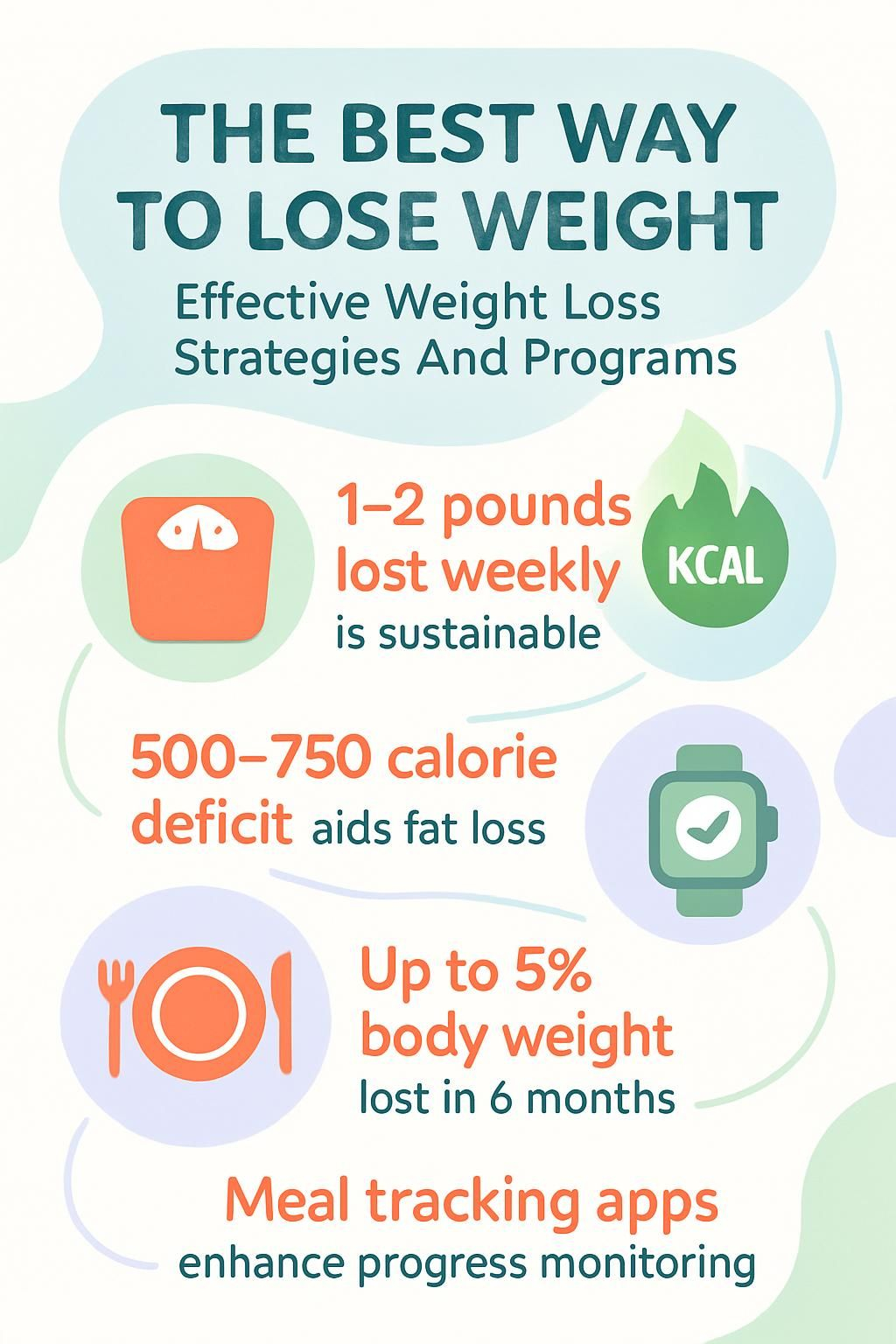The Best Way To Lose Weight: Effective Weight Loss Strategies And Programs
Our Nutrition Assistant AI Suite will transform your body. You will lose fat, get toned, and build muscle. Gain confidence and optimal health.
If you feel stuck trying to lose weight, you are not alone. More than 40% of adults in the United States live with obesity, according to the Centers for Disease Control and Prevention. This guide explains practical weight loss strategies that work, including smarter food choices, physical activity, and programs that support long-term weight management. You will find clear steps to help you lose weight safely and keep it off for a healthier life. This information is educational, not a medical diagnosis. Talk with your clinician if you have a medical condition or take prescription medicine.
Read on if you want real results that last.
Key Takeaways
- Over 40% of U.S. adults face obesity. Steady weight loss of 1–2 pounds per week is safest and most sustainable.
- A daily calorie deficit of 500–750 calories, paired with aerobic exercise and strength training, supports fat loss and metabolic health.
- Choosing whole, nutrient-dense foods over processed foods improves appetite control and lowers disease risk, according to the American Heart Association.
- Structured programs such as Weight Watchers or Noom improve accountability. Research shows average losses near 5% of body weight in six months.
- Tracking tools, wearable devices, and online support groups increase motivation and help you monitor progress.

Why Is Maintaining a Healthy Weight Important?

Keeping a healthy weight lowers your risk of heart disease and type 2 diabetes. It also supports energy, mobility, and everyday comfort.
What are common myths about losing weight?
Crash diets and very-low-calorie diets may promise fast results. Research shows they seldom lead to long-term weight loss. Many people regain much of the lost weight within one to five years. Another myth is spot reduction, the idea that certain exercises melt belly fat only. Science shows fat loss happens across the whole body.
Real change comes from a balanced eating plan, regular physical activity, stress control, and better sleep. Cutting out whole food groups, like all carbs, can remove important nutrients such as fiber and healthy fats found in whole grains and fruit. The American Heart Association recommends balanced meals and steady habits over strict restriction. Slow, steady progress at 1 to 2 pounds per week beats extreme methods. As many coaches say, lasting results come from daily choices, not drastic actions.
Setting the Foundation for Weight Loss
Strong results start with small, realistic changes in your routine. Build a simple base, then add steps you can repeat during busy weeks.
How do I find my motivation to lose weight?
Write your reasons to lose weight and keep them visible. Health, lower blood pressure, more energy for family, and greater confidence are common motivators. Studies show that writing down goals can strengthen commitment and improve long-term success.
Support helps when motivation dips. Join an online group or ask a friend to check in weekly. Track meals and activity with a journal or app if you prefer privacy. Many people who drop 10 pounds credit consistent tracking as a key habit.
How can I evaluate my current habits and lifestyle?
Honest tracking shows patterns that drive weight gain or weight maintenance. Use the steps below to spot what to change first.
- Track everything you eat and drink for three to seven days in a food diary. Note added sugar, processed foods, and takeout frequency.
- Record daily activity. Compare your minutes of walking, aerobic exercise, and strength training to guideline targets.
- Log sleep hours and sleep quality each night. Short sleep can alter hunger hormones and raise appetite.
- Rate daily stress from 1 to 10 or journal stressful moments. Notice if stress triggers emotional eating.
- Write your daily routines, including work hours, family meals, and snack times. Spot places and times that lead to overeating.
- Measure portion sizes with a scale or cups for one week. Compare to CDC and ChooseMyPlate.gov guidance.
- List challenges such as office treats, shift work, social events, or late-night snacking.
- Review your logs weekly. Identify which habits help and which push weight gain.
After a short tracking period, you may notice patterns, such as frequent sugary drinks at lunch that raise cravings later in the day.
What goals should I set to lose weight realistically?
Set goals that you can reach and repeat. Focus on actions you control, not just scale numbers.
- Target 1–2 pounds per week with a 500–750 calorie daily deficit from diet and activity.
- Start with 5% weight loss. For example, at 180 pounds, aim to lose about 9 pounds to improve health markers.
- Use action goals, like walking 30 minutes daily, and outcome goals, like losing 10 pounds.
- Make goals specific and short-term, such as swapping sugary drinks for water or adding a vegetable at dinner.
- Track progress weekly with weigh-ins or a food log. Adjust based on the data you collect.
- Build routines that last. Habits beat quick fixes and reduce rebound weight gain.
- Consult a registered dietitian if you want a tailored eating plan or have medical concerns.
Next, explore dietary strategies that make these goals easier to hit.
Effective Dietary Strategies
What you eat shapes your progress and your health. Choose patterns that fit your life, then repeat them until they feel natural.
How does creating a calorie deficit help with weight loss?
A calorie deficit means you eat fewer calories than your body uses. This pushes your body to tap stored fat for energy. Experts recommend a deficit of about 500 to 1,000 calories per day. That usually leads to a safe loss of 1 to 2 pounds per week for most adults.
Tracking intake keeps you on target. For example, if you maintain at 2,000 calories but eat 1,500, that 500 calorie gap may lead to about one pound lost per week. Pair the deficit with nutrient-dense foods to protect energy and mood.
Why focus on whole, nutrient-dense foods?
Whole foods, such as fruits, vegetables, whole grains, lean protein, and healthy fats, deliver vitamins, minerals, fiber, and antioxidants. These nutrients support fullness and make it easier to manage hunger.
People who eat several servings of produce daily reduce their risk for chronic disease and support modest weight loss. Replacing processed snacks with whole foods upgrades diet quality. Small swaps, like fruit with nut butter instead of chips, help reduce cravings and support steady weight maintenance.
How can I reduce processed foods and added sugars?
Cook more meals at home and pack snacks. Trade soda and sweetened coffee for water or unsweetened tea. Pick natural sugar in fruit instead of desserts with added sugars. For a simple swap, choose an apple or berries instead of candy.
Choose whole grains like oats, brown rice, and whole wheat bread. They help you feel full longer. Use healthy fats such as avocado and olive oil in small amounts. Reading labels for hidden sugars can make a big difference in daily calories and energy.
What are the benefits of increasing fiber and protein intake?
Fiber helps you feel full on fewer calories. Fruits, vegetables, beans, and whole grains are top sources. Higher fiber intake supports appetite control and may lower the risk of type 2 diabetes. It also supports regular digestion.
Protein helps maintain muscle while you lose fat. Choose chicken, fish, eggs, tofu, yogurt, or beans. Studies show that adequate protein can preserve lean tissue during weight loss. A mix of fiber and protein keeps hunger steadier between meals.
What is intermittent fasting and does it work?
Intermittent fasting limits eating to certain hours or days. A common pattern is 16:8, which means 16 hours of fasting and an 8-hour eating window. This schedule can help create a calorie deficit without strict food rules.
Research shows intermittent fasting can lead to weight loss similar to standard calorie restriction. Some people find it reduces late-night snacking and improves awareness of hunger cues. It is not for everyone. People with diabetes, pregnant women, and anyone on medication should talk with a healthcare professional before starting any fasting plan.
How Can Physical Activity Help Me Lose Weight?
Movement burns calories and protects your metabolism. Think of exercise as a daily deposit in your health bank.
What types of aerobic exercises are best for fat loss?
Aerobic exercise raises your heart rate and burns calories. Aim for at least 150 minutes of moderate effort or 75 minutes of vigorous effort each week.
- Brisk walking is simple and requires no gear. Try 30 minutes on most days.
- Running or jogging burns more calories. Interval sessions can boost results.
- Cycling, indoors or outdoors, works large muscles and supports weight loss.
- Swimming is full-body and low impact, which is kind to joints.
- Dancing raises your heart rate and can burn many calories depending on style.
- Jump rope provides a high calorie burn in little time.
- Rowing trains upper and lower body together and strengthens your core.
Pick activities you enjoy so you stick with them. Consistency drives the loss of 1 to 2 pounds per week.
How does strength training boost metabolism?
Aerobic exercise burns calories during the workout. Strength training helps your body burn more even at rest. Lifting weights or using resistance bands at least twice per week builds and preserves muscle. Muscle tissue uses more energy than fat tissue, which supports a higher resting calorie burn.
Research shows that pairing calorie control with resistance training helps you lose more body fat and protect lean mass. Many people notice clothes fit better within a few weeks, even before the scale shifts. Start with bodyweight moves like squats, push-ups, and rows. Add dumbbells or bands as you feel ready.
Strength sessions support metabolism, daily function, and mood. This makes it easier to keep up with any eating plan and avoid weight cycling.
Footnote:
1 Westcott WL et al., Preserving Lean Muscle During Weight Loss,
ACSM’s Health & Fitness Journal, May/June 2019.
How do I find enjoyable ways to stay active?
Enjoyment keeps you moving. Pick options that fit your life and feel rewarding.
- Choose activities you like, such as walking, swimming, or group classes. People exercise more often when they enjoy the activity.
- Climb stairs, park farther away, and add short walks. Small moves add up and support any low-carb diet or other plan.
- Stand for calls or use a standing desk. Standing can burn about 50% more calories per hour than sitting.
- Walk during TV time or take a short walk after meals to help control blood sugar.
- Join a local league or class for social support and accountability.
- Use a step goal with a wearable device. Seeing progress boosts motivation.
- Rotate activities to avoid boredom, for example swim Monday, walk Wednesday, lift Saturday.
- Invite a friend or family member to join you. A partner can raise consistency.
Blend activity into your week so it feels natural, not forced.
Lifestyle Changes for Sustainable Results
Small habits compound over time. Think about building a lifestyle that keeps the weight off.
How can I manage stress to support weight loss?
Stress can trigger emotional eating and skipped workouts. Use simple coping skills such as a brisk walk, music, journaling, or a quick call with a friend. Mindfulness and regular exercise lower stress hormones and help control cravings.
If stress feels constant or heavy, ask your healthcare provider for a referral to a registered dietitian or mental health professional. Getting support makes healthy routines easier to follow.
Why is quality sleep important for losing weight?
Sleep affects appetite and self-control. Adults need about 7 to 9 hours per night. Too little sleep disrupts hormones like leptin and ghrelin, which regulate hunger. That can raise cravings and reduce your desire to exercise.
Track your sleep along with food and activity. Many people notice better energy and fewer cravings after moving from six hours to eight. Rest is part of recovery, just like hydration and protein intake.
[1] National Sleep Foundation, Sleep Duration Recommendations (2015)
How much water should I drink daily for weight loss?
Hydration supports appetite control and digestion. A common goal is about 8 cups, or 64 ounces, of water per day for most adults. Choosing water instead of sugary drinks can lower your daily calories and support your plan.
Keep a refillable bottle with you. Sip before meals and during the day. People who have had bariatric surgery should follow their medical team’s specific advice on fluid intake.
How do I build a routine that supports long-term success?
Structure makes healthy choices easier and reduces decision fatigue. Use these steps to create a repeatable routine.
- Plan meals and snacks. Prep simple recipes so healthy food is ready when you need it.
- Wear comfortable clothes and shoes so you can be active anytime.
- Schedule workouts on your calendar. Set reminders for consistency.
- Track food with an app. People who self-monitor often lose more weight, based on National Weight Control Registry findings.
- Keep a regular bedtime. Adults need 7–9 hours for appetite and energy control.
- Drink water through the day. Aim for at least eight 8-ounce glasses.
- Join supportive communities. Share goals and milestones for accountability.
- Review your week. Keep what works and adjust one small step at a time.
- Keep activity fun. Try hiking, swimming, or dancing to stay engaged.
- Set clear daily targets, like 8,000 steps or vegetables at lunch and dinner.
Small adjustments, tracked over weeks, can lead to steady progress without feeling restrictive.
The Role of Weight Loss Programs
Programs add structure, tools, and accountability. Many people find they stick with healthy habits longer inside a supportive plan.
What are the benefits of using structured weight loss programs?
Structured programs offer clear guidelines, meal ideas, activity plans, and tracking tools. Regular check-ins build accountability. Many include lessons on nutrition and behavior change, which help your new habits last.
Group meetings or online forums provide social support. Studies show participants in structured programs often lose more weight than people who go alone. For example, Weight Watchers reports average losses near 5% of starting body weight in six months.
What are popular weight loss programs like Weight Watchers and Noom?
Weight Watchers uses a points system that guides food choices and portion control, along with weekly support. Noom focuses on behavior change with daily lessons and in-app tracking.
Other options include the Mayo Clinic Diet Online, which offers expert plans, and programs such as UC Davis Health’s Achieving a Healthy Weight
and Living Light Living Well.
These programs combine education, tracking, and support so you can lose weight safely and keep it off.
How do I choose a program that fits my needs?
Look for programs that support gradual, long-term weight management. Avoid extreme diets that promise rapid results without evidence. Review research-backed options and check whether registered dietitians or trained coaches are involved.
Decide if you prefer group meetings, an app experience, or both. Read user reviews to see which plans match your lifestyle and budget. Pick the level of structure and support that helps you stay consistent.
Using Technology to Support Weight Loss
Technology makes tracking easier and helps you see trends. A quick glance at your data can nudge you to stay on track.
What apps help with meal tracking and activity monitoring?
Food and activity logs improve awareness and outcomes. These apps simplify tracking and offer helpful feedback.
- MyFitnessPal logs meals, calories, and workouts, with barcode scanning and a large food database.
- Lose It! focuses on calorie counting with simple goal setting and food scanning.
- Mayo Clinic Diet App provides expert guidance and supports sustainable habits.
- Cronometer tracks detailed nutrition, including vitamins and minerals, with strong accuracy.
- Fitbit tracks steps, heart rate, sleep, and exercise when paired with a device.
- Noom includes tracking plus daily lessons on behavior change.
- Apple Health aggregates data from many apps and devices in one dashboard.
- Google Fit logs workouts and steps, and connects with wearables and partner apps.
- SparkPeople combines food logging with community support and challenges.
Many apps let you customize goals and see non-scale progress, like energy or sleep improvements.
How do wearable devices track my progress?
Wearables use sensors to measure steps, heart rate, calories, and sleep. You can view daily stats on your device or phone and set targets such as 10,000 steps per day or 30 minutes of moderate exercise most days.
Seeing charts and streaks can raise motivation. Automatic workout logging and reminders help you stay active, which supports weight loss. Sharing milestones in online groups adds accountability and encouragement.
How can online communities motivate me to lose weight?
Online communities connect you with people who share similar goals. Posting progress, joining challenges, and earning badges can keep you engaged. In a 2021 study, most participants who used forums regularly stuck with their plans for months.
These groups can help you navigate setbacks and celebrate wins. Pair community support with tracking tools or wearables to build a complete system for change.
Overcoming Common Challenges
Roadblocks happen. A simple plan to troubleshoot them can protect your momentum.
Why do weight loss plateaus happen and how can I overcome them?
Your body adapts to lower weight and intake, so metabolism can slow during weight loss. A National Institutes of Health study showed resting metabolic rates dropped about 500 calories per day during extended weight loss periods [1]. Stress and poor sleep can also stall fat loss.
Break a plateau by checking portions, tightening tracking, and adding activity. Try more steps, short intervals, or slightly higher protein. Hydrate well and aim for 7 to 9 hours of sleep. If progress stalls for weeks, consider a brief maintenance period, then restart with a small calorie deficit.
[1] Hall KD et al., Energy Expenditure and Body Composition Changes After an Isocaloric Ketogenic Diet in Overweight and Obese Men,
American Journal of Clinical Nutrition (2016)
What strategies help combat emotional eating?
Emotional eating blurs hunger and feelings. Use these steps to create space between mood and food.
- Track mood and eating in a journal to spot triggers.
- Use coping skills such as walking, deep breathing, or calling a friend.
- Plan regular meals and snacks to reduce impulse decisions.
- Practice mindful eating. Slow down and notice hunger and fullness.
- Seek professional help if emotional eating feels frequent or hard to control.
- Use tracking apps to reveal patterns and build awareness.
- Join support groups to share strategies and feel less isolated.
- Protect sleep, activity, and hobbies that reduce stress.
- Set realistic goals and use non-food rewards for progress.
- Drink water since thirst sometimes feels like hunger.
Writing feelings before eating can break the link between stress and snacking. That brief pause helps you choose based on hunger, not emotion.
How do I stay consistent despite setbacks?
Everyone has off days. Treat setbacks like feedback and update your plan. If you miss a workout or overeat, reset at the next meal or schedule your next session now.
Use non-food rewards such as flowers, a new book, or a relaxing bath. Small rewards raise consistency and reduce stress after slip-ups. A positive, flexible mindset helps habits stick.
Tips for Long-Term Maintenance
Long-term weight loss depends on habits you can repeat. Small, steady actions keep the scale moving the right way.
Why focus on lifestyle changes instead of quick fixes?
Crash diets can cause fast losses, but most people regain the weight. Quick cuts can also reduce muscle and slow metabolism, which makes future weight management harder.
Lifestyle change shapes eating patterns, physical activity, sleep, and stress. Simple swaps, like water instead of soda or a daily walk, add up. Sustainable methods reduce the chance of regaining pounds later.
How should I monitor myself and adjust my plan regularly?
Tracking shows what works and what needs a tune-up. Use data to guide small adjustments.
- Weigh in weekly, same scale and day, and log results.
- Measure waist, hips, and arms every two weeks to see body changes beyond the scale.
- Keep a food diary and use barcode scanning for accuracy.
- Log activity, steps, and workouts to see patterns.
- Review goals weekly or monthly and set new targets as you hit old ones.
- Adjust calories, workouts, or food choices if you spot a plateau.
- Celebrate wins like better sleep, energy, or fitness levels.
- Ask a clinician or registered dietitian for guidance if progress stalls.
Many people discover extra sugar in their logs and swap dessert for fruit. That single change can cut hundreds of calories per day without hunger.
What are examples of non-scale victories to celebrate?
Progress is more than a number. These wins show real change in health and daily life.
- More energy throughout the day and less afternoon fatigue.
- Better sleep quality and waking up refreshed.
- Improved mood and lower stress with regular activity.
- Clothes fitting better or moving to a smaller size.
- Gains in strength or endurance, like longer walks or heavier lifts.
- Improved medical markers such as blood pressure or cholesterol.
- Fewer cravings for sweets and processed foods.
- Sharper focus at work or school due to steadier blood sugar.
- Non-food rewards, like new workout gear, to mark milestones.
- Personal achievements, such as finishing a 5K or enjoying a hike.
These victories build confidence and keep motivation high, even if the scale moves slowly.
Conclusion
Long-term weight loss takes patience, steady habits, and honest tracking. Focus on nutrient-dense foods, a workable calorie deficit, and regular physical activity to support a healthy weight. Structured programs and technology can provide accountability and clarity.
Expect challenges and adjust as needed. With consistent steps, supportive tools, and a growth mindset, you can lose weight and maintain your results for a healthier life.
FAQs
1. What are the most effective weight loss strategies supported by research?
Research shows that a balanced eating plan, regular physical activity, and behavioral changes lead to lasting weight loss. Studies from the Centers for Disease Control and Prevention highlight that reducing calorie intake while increasing exercise is key to success.
2. How do structured programs help with losing weight?
Structured programs offer guidance, support, and accountability. Many clinical trials show people in organized groups lose more pounds than those who try alone. These programs often include meal planning, group meetings, or coaching sessions.
3. Are there any risks with rapid weight loss methods?
Rapid methods can cause muscle loss or nutritional gaps according to data from the National Institutes of Health. Safe plans aim for one to two pounds lost per week using gradual changes in diet and activity levels.
4. Can personal experience improve results when following a program?
Sharing progress with others helps many stay motivated based on findings published in peer-reviewed journals like Obesity Reviews. In my own journey, joining a local walking club made it easier to stick with daily exercise goals.
Summary: Evidence supports steady lifestyle changes over quick fixes for long-term results; structured support increases success rates; slow progress lowers health risks; sharing experiences boosts motivation during your journey toward better health outcomes.







